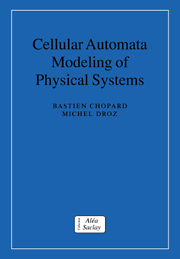1 - Introduction
Published online by Cambridge University Press: 26 October 2009
Summary
Brief history
Cellular automata (often termed CA) are an idealization of a physical system in which space and time are discrete, and the physical quantities take only a finite set of values.
Although cellular automata have been reinvented several times (often under different names), the concept of a cellular automaton dates back from the late 1940s. During the following fifty years of existence, cellular automata have been developed and used in many different fields. A vast body of literature is related to these topics. Many conference proceedings), special journal issues and articles are available.
In this section, our purpose is not to present a detailed history of the developments of the cellular automata approach but, rather, to emphasize some of the important steps.
Self-reproducing systems
The reasons that have led to the elaboration of cellular automata are very ambitious and still very present. The pioneer is certainly John von Neumann who, at the end of the 1940s, was involved in the design of the first digital computers. Although von Neumann's name is definitely associated with the architecture of today's sequential computers, his concept of cellular automata constitutes also the first applicable model of massively parallel computation.
Von Neumann was thinking of imitating the behavior of a human brain in order to build a machine able to solve very complex problems. However, his motivation was more ambitious than just a performance increase of the computers of that time.
- Type
- Chapter
- Information
- Cellular Automata Modeling of Physical Systems , pp. 1 - 20Publisher: Cambridge University PressPrint publication year: 1998
- 1
- Cited by



